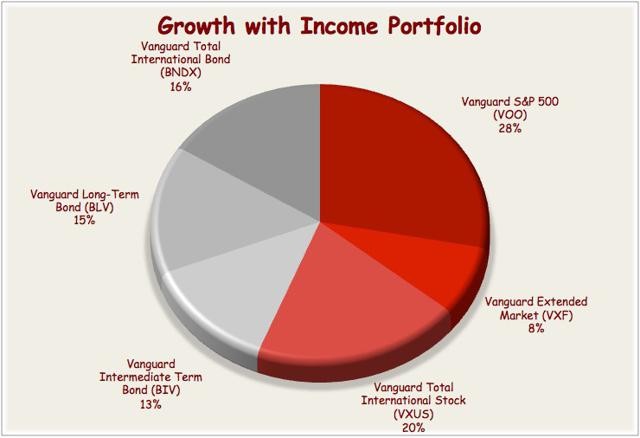Retirement Income ETF Portfolio
Post on: 21 Май, 2015 No Comment

A relative recently approached me for investing advice. This relative, well call him Uncle Alex, is approaching retirement and is wondering how to create an income portfolio. Uncle Alex was a small business owner for most of his working life and managed to accumulate a fair bit of capital to fund his retirement years.
Some professionals recommend a 50/50 equity/bond split during retirement so that the portfolio will last 30 years with a high certainty of success assuming a 4% annual withdrawal (adjusted for inflation). In my opinion though, it depends on the risk tolerance of the investor. Theres no point putting Uncle Alex in 50% equities if he cant sleep at night due to the volatility of the market. For example, if he was 50% equities during the downturn of 2008, there was a point where his entire portfolio could have fallen as much as 25%.
Besides the asset allocation, theres the task of choosing appropriate investments that produce income. Unfortunately, right now with interest rates at record lows, short term fixed income yields are unattractive. However, in addition to the cash that fixed income produces, there is the benefit of reduced portfolio volatility.
To keep things simple, lets assume that we go 45% stocks and 45% bonds and 10% cash. Assume that Uncle Alex has enough capital to live off the distributions of the portfolio without having to touch the capital. However, well leave some cash in place should he need a lump sum in the future.
Having said that, here are the investment vehicles that I would consider using for an ETF income portfolio:
Equities
Strong Dividend Equities. CDZ (MER: 0.60%) or XDV (MER: 0.50%) and VIG (MER: 0.28%) These ETFs have different focuses, but produce a strong dividend income stream. CDZ mimics the dividend achievers list which focuses on Canadian companies that have a history of increasing their dividends over time. XDV focuses on Canadian blue chips with the highest yield. Although CDZ has a slightly higher MER, it has a higher distribution as it holds income trusts. As well, it distributes monthly instead of quarterly. VIG is similar to CDZ except that it focuses on the US dividend achievers index .
Real Estate. XRE (MER: 0.55%) Although Riocan (REI.UN) is a large weighting on this real estate investment trust ETF . I like the diversity that it provides across Canada. If the risk tolerance was a bit higher, I would simply buy the top 3 REITs which covers 50% of the index, offer a higher yield, and save the annual MER.
Preferred Shares. CPD (MER: 0.45%) This is Claymores preferred share ETF which covers the Canadian preferred share index. With preferred shares, you get lower volatility than equities and a higher yield. However like bonds, preferred shares are sensitive to interest rate fluctuations. Look for this ETF to become cheaper if interest rates rise aggressively.
Fixed Income
Short Term Bonds. XSB (MER: 0.25%) or CLF (MER: 0.15%) The shorter the duration of the bond, the lower the correlation with the overall market which is why short term bonds have a place in every portfolio (IMO). XSB is an iShares product that has a fairly low MER and holds both government and corporate short term bonds. CLF on the other hand has an even lower MER but holds only government short term bonds. My preference leans towards CLF as it has a lower MER but similar yield as XSB.
Corporate Bonds. XCB (MER: 0.40% ) or CBO (MER: 0.25%) Investment grade corporate bonds are considered slightly higher risk than government bonds, but offer higher yields. The iShares XCB has a slightly higher MER, but also a higher yield with a duration of 5.27 years. The Claymore laddered corporate bond ETF CBO has a lower MER and a shorter duration of 2.64 years.
Real Return Bonds. XRB (MER: 0.35%) Real return bonds provide a hedge against inflation as they provide an interest rate over and above the inflation rate. Although the yield might be a bit lower, XRB provides protection during an volatile interest rate period.
Cash
GIC Ladder For this portion of the portfolio, a 5 year GIC ladder would be constructed. When the bottom rung matures every year, it will be reinvested in the highest 5 year rate available.
Ideal Income ETF Portfolio (assume 45/45/10)
- CDZ 15% (current yield: 4.26%)
- VIG 5% (current yield: 1.83%)
- XRE 10% (if buy top 3 REITs, current yield: 5.57% or 3.66% with XRE )
- CPD 15% (current yield: 5.10%)
- CLF 15% (current yield: 4.18%)
- CBO -15% (current yield: 4.67%)
- XRB -15% (current yield: 2.38%)
- GIC Ladder 10% (assume current yield: 2.40%)
Total Yield (as of April 2010): 4.01%
A couple considerations is that Canadian dividends face a gross up of 45% which is counted as income when testing seniors benefits. For example, a senior can make up to around $67k before facing clawbacks of 15% for every dollar above the threshold. However, in this particular case, Uncle Alex will be splitting the income proceeds with his spouse, which means the total distributions wont reach the OAS claw back threshold .














